Harbor Seals
Harbor seals (Phoca vitulina richardsi) are pinnipeds whose diets are diverse, often reflect regional and seasonal availability of prey, and include many species also eaten by Steller sea lions (SSL). Harbor seal numbers declined more than 80% in western Alaska in the 1970s and 1980s, coinciding with noted declines in SSL numbers. But unlike the slow recovery of SSL numbers in the Kodiak area, the number of harbor seals on eastern Kodiak haulouts has been increasing steadily since the early 1990s (as much as 8% annually in some areas).
If sympatric seal lions and harbor seals really do eat the same prey, why aren’t both species recovering at the same rate? The fact that seal numbers have increased while sea lion numbers have merely stabilized in the Kodiak region led to a series of GAP questions:
- Do seals and sea lions eat the same prey in the same places and times?
- Is the availability of prey limited for sea lions but not harbor seals?
- Are factors other than prey availability regulating these pinniped populations in the Kodiak area?
- How does prey consumption by an increasing seal population play into the Kodiak marine food web?
To explore the degree to which the seasonal diets and foraging habits of harbor seals and Steller sea lions overlap within the Kodiak archipelago, we worked closely with Alaska Department of Fish and Game (ADFG) seal researchers and used a combination of scat analysis and dive-depth monitoring to:
- compare relative importance of prey species recovered from harbor seal and Steller sea lion scats collected on juxtaposed sites
- compare seal foraging depths and times to those of tagged whales in Uganik Bay (GAP 07)
Harbor Seal Diet
A total of 629 harbor seal scats collected in the Kodiak area by GAP or ADFG personnel from April 2001 to March 2008 were processed and their dried remains identified to the lowest possible taxa. Harbor seals using haulouts in the Kodiak area were found to have a diverse diet. Combined across the region and seasons, a total of 36 different prey species/items were present in at least 1% of seal scats examined. Seventeen prey items were found to be significant prey items, as defined by their occurrence in at least 5% of scats with identifiable remains. Six of these prey species were found in >10% of scats containing identifiable prey. In order of their frequency of occurrence, these included Irish lords, rock sole, greenlings, Pacific cod, Pacific sand lance, and arrowtooth flounder.
Comparison of Harbor Seal and Sea lion Diets
Including scat data from complementary ADFG diet studies in the Kodiak area, we were able to compare the contents of 1565 harbor seal scats and 3369 Steller sea lion scats collected in 2000–2009 on haulout sites of the Kodiak archipelago. We found that harbor seals and Steller sea lions in the Kodiak area have diverse diets that include dozens of prey species, many of them in common. For both species, Pacific sand lance, Pacific cod, and arrowtooth flounder were found to be important and present in >10% of the scats examined (Figure 1).
The relative importance of each prey item to the seals and sea lions sampled differed, however. When the “top 10” most frequently appearing prey items in seal diets (Figure 1) are compared to the Steller sea lion top 10 (Figure 2), clear differences in how these pinnipeds utilized the prey base were apparent. Seals and sea lions appear to forage predominantly in different habitats (pelagic vs demersal) where different prey dominate. As a result, the broad diet of the harbor seals we sampled was dominated by benthic, demersal, non-schooling species including Irish lords and greenlings. The Steller sea lion scats sampled, however, demonstrated a greater use of pelagic, schooling species including, pollock, cod, and salmon, and a variety of forage fish including sand lance, herring, and capelin.
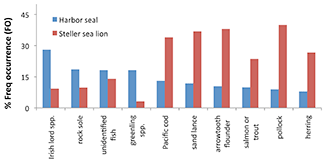 Figure 1. Frequency of occurrence (FO) of the top 10 ranked prey items found in 1565 Kodiak area harbor seal scats compared to their FO in 3369 Kodiak area Steller sea lion scats collected in 2000–2009. Click image for larger version.
Figure 1. Frequency of occurrence (FO) of the top 10 ranked prey items found in 1565 Kodiak area harbor seal scats compared to their FO in 3369 Kodiak area Steller sea lion scats collected in 2000–2009. Click image for larger version.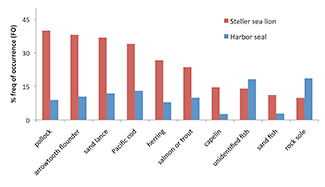 Figure 2. Frequency of occurrence (FO) of the top 10 ranked prey items found in 3369 Kodiak area Steller sea lion scats compared to their FO in 1565 Kodiak area harbor seal scats collected in 2000–2009. Click image for larger version.
Figure 2. Frequency of occurrence (FO) of the top 10 ranked prey items found in 3369 Kodiak area Steller sea lion scats compared to their FO in 1565 Kodiak area harbor seal scats collected in 2000–2009. Click image for larger version.Harbor Seal Tagging and Dive Data (GAP 07)
In late October 2007, GAP personnel collaborated with a team of Alaska Department of Fish and Game (ADFG) harbor seal researchers led by Dr. Gail Blundell to capture 25 harbor seals in Uganik Bay (NW Kodiak) (Figure 3). A variety of satellite-linked and VHF tags were attached to 20 of the seals to allow tracking of movements and dive patterns of individual seals (Figure 4).
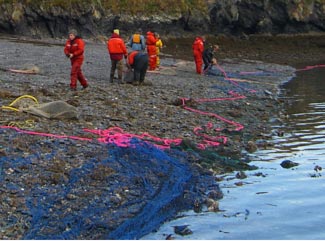 Figure 3. GAP personnel assisted ADFG with harbor seal captures in Uganik Bay, Oct 2007.
Figure 3. GAP personnel assisted ADFG with harbor seal captures in Uganik Bay, Oct 2007.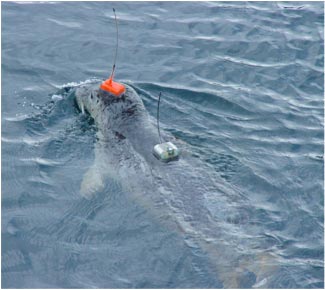 Figure 4. A total of 20 harbor seals were outfitted with VHF radiotags glued to their head and/or satellite-linked time-depth recorders glued to their back, Oct 2007. These tags were shed off the animals during the following summer molt. Photo by ADFG.
Figure 4. A total of 20 harbor seals were outfitted with VHF radiotags glued to their head and/or satellite-linked time-depth recorders glued to their back, Oct 2007. These tags were shed off the animals during the following summer molt. Photo by ADFG.ADFG provided a visual summary of 24,514 satellite-linked locations that were recorded telemetrically for seals tagged in Uganik Bay through the tags’ duration. Individual seals used Uganik Bay habitat to varying degrees: several left Uganik Bay soon after capture and spent the rest of the winter as far north as Anchorage and as far south as Chignik, while others used the bay almost exclusively (Figure 5).
Seven tagged seals used Uganik Bay during the months GAP was conducting concurrent prey and whale tagging studies in winter 2007–2008. The majority of 25,556 dives recorded for these seals were very shallow (4–10m); less than 1% of dives reached a maximum depth greater than 200 meters (Figure 6). Shallow dives likely involved seals that were traveling and resting near haulouts as well as foraging in nearshore waters.
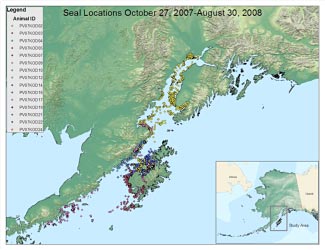 Figure 5. Map showing locations of tagged harbor seals tracked from October 2007 to August 2008. Each color depicts movements of an individual seal that was tagged on a haulout within Uganik Bay in late October 2007. Click image for larger version.
Figure 5. Map showing locations of tagged harbor seals tracked from October 2007 to August 2008. Each color depicts movements of an individual seal that was tagged on a haulout within Uganik Bay in late October 2007. Click image for larger version.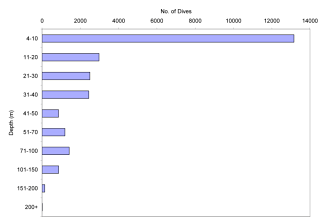 Figure 6. The number of harbor seal dives occurring within each of 10 depth bins. Only harbor seals with location data within the bounds of the study area are included. Click image for larger version.
Figure 6. The number of harbor seal dives occurring within each of 10 depth bins. Only harbor seals with location data within the bounds of the study area are included. Click image for larger version.We compared seal dive depths to acoustic sign recorded during prey surveys conducted with the ADFG R/V Resolution to assess their association with herring and non-herring prey in Uganik Bay. If the shallowest dives (4–10m) were excluded from regression analyses, a significant linear relationship was found between herring backscatter and the number of harbor seal dives for both surveys combined. The distribution of harbor seal locations also suggests a potential affiliation with herring biomass; relatively more locations were documented in the Northeast Arm of Uganik Bay where most herring backscatter was concentrated.
While baleen whales were apparently foraging on zooplankton in our winter study, scat evidence suggests Uganik Bay harbor seals were likely exploiting the locally abundant herring and pollock schools, with herring consumption increasing into spring. We found a degree of dietary overlap between Uganik Bay pinnipeds that varied seasonally. While both seals and sea lions fed on salmon and herring when they were seasonally abundant, Steller sea lions had a more diverse diet and consumed relatively more demersal and benthic species including flounders, soles, and Pacific cod in winter than did seals.


